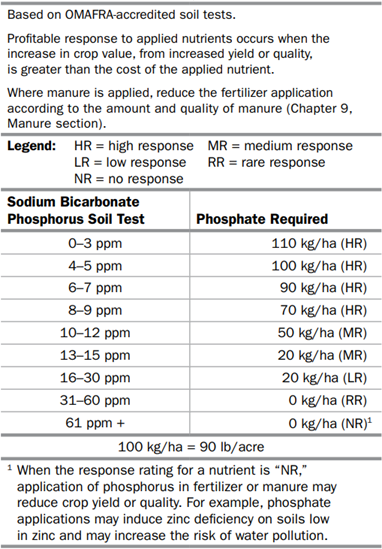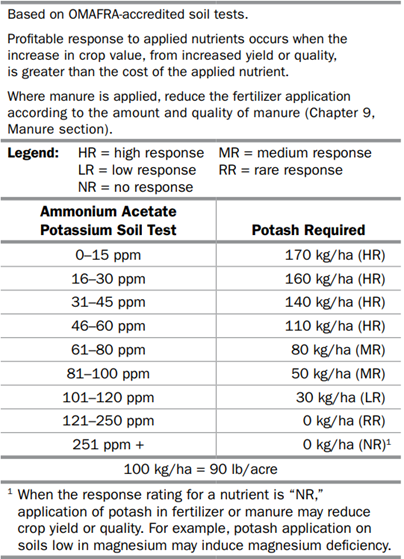Production Requirements
Soil Types: Sunflowers are suited to most soil types. Yields are lower on poorly drained or very light soils
Soil pH: 6.0–7.5
Recommended Rotational Crops: Corn, cereal crops
Should Not Rotate With: Soybeans, dry edible beans, canola, camelina and buckwheat
Minimum Soil Temperature: 6°C
Optimum Air Temperature: 25°C–28°C
Earliest Planting Date: Early May
Required Growing Season: 100–120 days
Sunflower is a tall, broad-leaved, usually single-stemmed plant, with one head per plant. Plants are heliotropic, which means that the heads follow the day’s sun. They have a deep taproot, which allows them to access deep water and nutrient supplies that are generally unavailable for many other annual crops. As a result, sunflowers can handle dry soil conditions better than most crops.
Sunflowers have been grown in Ontario for several decades. The main markets for Ontario sunflowers have been for birdseed and confectionery uses. Both black seeded and striped sunflower seeds are sold into the birdseed markets. Currently there are no sunflower oilseed crushing markets in Ontario. Acreage in Ontario has ranged between 500–1,000 ha (1,250–2,500 acres) over the past decade.
Variety Selection
Sunflowers can be classified as either oil or confectionery. Oil-type sunflowers have black hulls and can be conventional hybrids, dwarf hybrids, mid-oleic or open pollinated varieties. Dwarf hybrids mature 6–13 days earlier than conventional hybrids. Open pollinated sunflower (Sunola) varieties are shorter stature 60–90 cm (2–3 ft), have high oil content and require less heat to mature than normal sunflowers, but they do not have good disease resistance.
Confectionery sunflowers have striped hulls and are grown for the human food market. Of the confection sunflowers, only the varieties producing the largest seed are used for human consumption, but these varieties are susceptible to bird and insect damage.
Hybrids have many advantages over open-pollinated varieties. Advantages include:
- approximately 20% greater yield
- better disease resistance (e.g., downy mildew, rust verticillium wilt)
- high degree of self-compatibility, which reduces the need for pollinators
- more uniform height and moisture content at harvest
Variety testing is conducted through the National Sunflower Association of Canada, with information available (www.canadasunfower.com).
Rotation
Sunflowers should not be planted in the same field more than once every 4–5 years, due to disease build-up. Canola, dry edible beans, soybeans, buckwheat and hemp are all hosts of white mould (Sclerotinia). Closely monitor rotations with these crops or avoid them altogether.
Volunteer sunflowers can also be a problem in some crop rotations. Sunflowers are susceptible to herbicide carryover from herbicides such as atrazine and sulphonylurea (ALS) herbicides.
Tillage and Seedbed Preparation
Sunflowers require a firm, moist and weed-free seedbed. Conventional tillage is usually preferred over no-till, mainly for weed control.
The best crop performance is on well-drained, medium-textured soils. Sunflowers can also grow well on sandy soils, but yield will be reduced under moisture stress during dry conditions. Poorly drained soils will delay planting, delay growth and increase disease pressure.
Planting
Sunflowers are planted in early May, similar to corn, and usually bloom in late July. They require approximately 100–120 days to mature. Seedlings are relatively tolerant to frost, up to the 4-leaf stage. A delay in planting beyond May 15 could increase the risk of frost damage prior to maturity in the fall. When delays in planting are unavoidable, use early-season hybrids/varieties.
Optimum planting depth is 3–5 cm (1.25–2 in.), and not more than 8 cm (3.25 in.), into moisture. Sunflowers are prone to lodging in heavier soils or where there is heavy rain and wind.
Ideal row width is 60–90 cm (24–36 in.). Use a corn planter with appropriate seed adjustments or a grain drill with some of the runs blocked-of. Row crop unit planters are preferred since grain drills typically result in poorer emergence. The recommended seeding rate is 40,000–60,000 plants/ha (16,000–24,000 plants/ acre). Confection sunflowers should have a final stand target no greater than 45,000 plant/ha (18,000 plants/ acre), to help encourage large seed size. Narrow row spacing, 18–25 cm (7–10 in.), increases the risk of white mould. Planting east/west can decrease lodging as sunflower heads face to the east and cause plants to bend in that direction.
Fertility Management
The recommended amount of nitrogen for sunflowers is 90 kg/ha (80 lb/acre). Nitrogen fertilizer use is most efficient when it is applied as a side-dress before the plants are 30 cm (12 in.) tall. Phosphorus and potassium fertility should be at target soil test levels (12–18 ppm P and 100–130 ppm K). If soil phosphorous and potassium levels are below target ranges, incorporate these nutrients into the soil ahead of planting, at rates that meet crop removal rate plus an amount that will build up the soil test over time. See Tables 7–5, Phosphate guidelines for sunflowers and 7–6, Potash guidelines for sunflowers.
Where manure is applied, reduce the fertilizer application according to the amount and quality of manure.
Table 7–5. Phosphate (P2O5) guidelines for sunflowers

Table 7–6. Potash (K2O) guidelines for sunflowers

Harvest and Storage
Harvest
Typical sunflower yields in Ontario range from 1,500–2,000 kg/ha (1,300–1,800 lb/acre). Plants are ready for harvesting when the back of the heads turn yellow and bracts around the head are brown, hard and dry. Seeds at this stage have approximately 50% moisture. Harvest typically occurs between September and mid-October. Timely harvest that occurs when the crop reaches maturity will prevent bird damage and head rot.
Sunflowers are best harvested with a combine equipped with a western-style or modified row crop head. Some producers have had success with a small grain head, but grain loss is usually higher. Most combines are adapted with long seed-gathering pans extending in front of the cutter bar to collect and salvage shattered seed. The reel is typically removed or raised for sunflower harvest. To prevent seed damage, use the slowest cylinder speeds with the largest openings. Reduce air flow to prevent seeds from being blown through the back.
Drying of a late maturing crop will be facilitated by a killing frost; however, early frost may reduce yield and oil content. To avoid shatter loss and exposure to birds, harvest at a higher percentage moisture and dry seeds.
Storage
After harvest, clean seed to remove dockage. For proper storage, seed must contain 9.5% moisture or less. Dry seed at higher moisture content immediately after harvest. Sunflowers dry easily in conventional grain dryers. Confection types may wrinkle or be scorched. Use low-temperature drying to prevent heat damaged, scorched or burned sunflower seeds. Heat damaged seeds will have a distinct odour and appearance that is disliked by birds and consumers, and are therefore difficult to market. Higher drying temperature can also be a fire risk. Allow the crop to cool before storing. In general, bins will hold 70% as much tonnage as grain corn.
Caution
Dry sunflower seeds at a low temperature, because fine hairs and fibres from the seed coat could ignite when put through the drying fan.
Weed Control
Sunflower seedlings suffer from weed competition. Early season weed control is important for maximum crop performance. As sunflowers mature, they become better able to compete with weeds.
The crop can be harrowed before seedling emergence to remove emerging weeds before they become established. A light spring-tooth harrowing can remove late-emerging weeds when sunflower seedlings are between the 4- and 6-leaf stage. Harrowing is best done under hot, dry conditions to reduce crop damage. Inter-row cultivation is also recommended.
For herbicide options refer to OMAFRA Publication 75, Guide to Weed Control. Herbicide tolerant sunflower varieties allow for an effective chemical weed control. Refer to seed suppliers for more information.
Insects and Diseases
Insects are typically not a problem in sunflowers when first introduced in a region. After several years, pest populations will build. Scouting and control measures will have to adapt to maintain productivity.
Banded sunflower moth has been a major pest, feeding on sunflower florets and seeds. The moth is small, straw-colored, about 7 mm (0.3 in.) long with a brown triangular area in the middle portion of the front wings. Larvae emerge 1.5 mm (0.6 in.) long, light-coloured with a dark brown head and they darken to reddish-purple and finally green colour at maturity. Full grown larvae are about 10 mm (0.4 in.).
Seed will pass normally through the combine with damage from mild infestations; however, severe infestations can inhibit harvest due to uneven maturing of heads combined with secondary disease infection.
Harvested seed from infected fields can also be a source of banded sunflower moth. Keep the sunflowers cool and dry. If stored for long periods, the larva will hatch and consume stored grain. Any escaping moths are difficult to control and can contaminate grain storage bins, warehouses and retail areas.
Sclerotina or white mould is the most important disease in sunflower crops. Descriptions of insects, pests and diseases, scouting and management strategies can be found in Insects and Pests of Field Crops and Diseases of Field Crops.
Suggested treatments to control insects, pests and diseases can be found in OMAFRA Publication 812, Field Crop Protection Guide.
For more detailed sunflower production information, see the Sunflower Production Guide of the National Sunflower Association of Canada at www.canadasunfower.com.